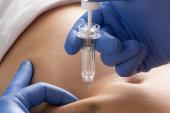Anticoagulation Use Quickly Rose to Meet COVID-19 Need
Observational data trace the swift but widely variable uptake of anticoagulants, and offer clues to the most effective doses.

Awareness about COVID-19’s prothrombotic qualities that emerged early in the pandemic soon translated into broad use of anticoagulation to prevent venous thromboembolism (VTE), a Michigan registry indicates. The data show that prophylactic—but not treatment-level—dosing was associated with better survival at 60 days.
“Practice changed rapidly over time,” said Valerie M. Vaughn, MD (University of Utah, Salt Lake City), lead author of the new report. She said the patterns captured here, from the spring and early summer of 2020, mirror what she saw firsthand as a hospitalist working in a hard-hit region. The changes also were quite large. “If I get people to change practice by 5% over 2 years, I’m happy. And this was week by week—we saw huge changes,” said Vaughn, who is a quality-improvement researcher.
“We went from not that many patients getting anticoagulated at all, to doing it in 100% of patients. You saw there being a lot of missed doses early on, to that nearly going away. And you saw also this rise in therapeutic instead of prophylactic dosing, and I saw that clinically in our practice: that different people were doing different things,” she observed.
“Some of that was good,” said Vaughn, but not all. Their paper, published online recently in JAMA Network Open, points toward the idea that lower is better when it comes to anticoagulation.
If I get people to change practice by 5% over 2 years, I’m happy. And this was week by week—we saw huge changes. Valerie M. Vaughn
Erik Klok, MD, PhD (Leiden University Medical Center, the Netherlands), commenting on the new study for TCTMD, agreed that the optimal strategy for anticoagulation in COVID-19 remains “an extremely important topic,” one for which there isn’t yet consensus.
Current guidelines emphasize prophylactic dosing, but more than 30 randomized trials have been launched to study the question. Thus far, only two—ACTION and INSPIRATION—have been peer reviewed and published, with neither showing an advantage to full-dose anticoagulation; their results stand in contrast to findings from an international, multiplatform trial released earlier this year by press release and slide set, now available in preprint. Notably, all of these trials excluded patients at highest bleeding risk, so they aren’t fully reflective of daily clinical practice, Klok added.
The current report contributes to the literature by lending support to the guidelines, Klok said, and it also shows that “clinical practice seems to confirm what experts recommend.”
Klok cautioned, however, that observational data can’t show a causative link between treatment and outcomes. “Everything is valuable knowledge, but we should put it in the right perspective,” he stressed. Anything apart from RCTs, despite their limitations, “adds to the speculation.”
MI-COVID19 Consortium
For their cohort study, Vaughn and colleagues analyzed data from 30 hospitals participating in MI-COVID19, a quality initiative sponsored by Blue Cross Blue Shield of Michigan and Blue Care Network. They looked at 1,351 adults hospitalized with COVID-19 between March 7 and June 17, 2020; median age was 64 years, 47.7% were women, and 48.9% were Black.
Among them, just 18 (1.3%) had confirmed VTE, yet 219 (16.2% of the whole cohort) received treatment-dose anticoagulation. ICU patients were much more likely to receive the higher dose than were general-care patients (31.1% vs 9.8%; P < 0.001). Practices varied widely across hospitals, with anywhere from 0 to 29% of patients receiving therapeutic anticoagulation despite a lack of VTE diagnostic imaging. Use of the higher dose also increased over time (adjusted OR 1.46 per week; 95% CI 1.31-1.61).
A total of 1,127 patients received prophylactic anticoagulation, but around a third of those who did so had a nonadherence period lasting 2 or more days. The proportion of patients who missed prophylaxis varied from 11% to 61% across hospitals, but it shrank as time progressed (adjusted OR 0.89 per week; 95% CI 0.82-0.97). Nonadherence was linked to higher risk of 60-day mortality (adjusted HR 1.31; 95% CI 1.03-1.67) but had no impact on inpatient mortality.
Treatment-dose anticoagulation was linked to lower in-hospital mortality (adjusted 0.38; 95% CI 0.25-0.58), as was prophylactic (adjusted HR 0.36; 95% CI 0.26-0.52). By 60 days, however, only the prophylactic dose was associated with a mortality reduction (adjusted HR 0.71; 95% CI 0.51-0.90).
A Return to Standard of Care?
At a hospital level, the goal should be to work toward getting all patients anticoagulation as consistently as possible, Vaughn stressed. “The thing that we know with 100% certainty is that in the absence of a true contraindication [like active bleeding], they need to be given prophylactic anticoagulation. That’s the thing we know is absolutely true.” If patients are reluctant, nurses and other clinicians at bedside need to explain why anticoagulation is needed and to avoid missed doses, she advised.
One key takeaway, more broadly, is to move away from therapeutic dosing unless the patient is thought to have a VTE, said Vaughn. Another is that long-standing approaches to caring for critically ill patients remain valid, she added. “Standard of care before [COVID-19] was prophylactic-dose anticoagulation.”
Their research “suggests that maybe we should be sticking with that unless there’s randomized trial data that comes out that supports that the higher dose is better. . . . I’m obviously waiting with bated breath the final results of the trials. Because once we find that out, I think that will supplant a lot of what we found in this study,” Vaughn commented.
Andrew B. Dicks, MD, and Ido Weinberg, MD (Massachusetts General Hospital, Boston), writing in an accompanying editorial, also emphasize that uncertainty continues.
With the latest analysis by Vaughn et al, “practically, we still lack the granular data we need to help guide us in patient-by-patient decision-making—such as anticoagulation agent choice, dosage, and duration of therapy—especially as dictated by acuity of patient illness,” they write. “Despite the limitations, this study (especially in the context of other published data) should make clinicians more confident that the use of prophylactic anticoagulation is warranted for hospitalized patients with COVID-19, as currently suggested by published societal guidelines. We eagerly await randomized trial data, while secretly hoping that by the time these are published we will have little need for their conclusions.”
We develop very good vaccines, and we give everybody vaccines. That’s the only way. Erik Klok
In the end, the lessons learned about anticoagulation will offer insight not only for COVID-19 but also future pandemics, he predicted.
Better understanding of how knowledge spread so rapidly during COVID-19 could prove useful in other areas of medicine, Vaughn pointed out. “If we can figure out what worked so well during the early weeks and months of COVID, maybe we can use some of that to improve care in other places.”
Caitlin E. Cox is News Editor of TCTMD and Associate Director, Editorial Content at the Cardiovascular Research Foundation. She produces the…
Read Full BioSources
Vaughn VM, Yost M, Abshire C, et al. Trends in venous thromboembolism anticoagulation in patients hospitalized with COVID-19. JAMA Netw Open. 2021;4(6):e2111788.
Dicks AB, Weinberg I. Further evidence supporting the use of prophylactic anticoagulation in hospitalized patients with COVID-19. JAMA Netw Open. 2021;4(6):e2112403.
Disclosures
- This work was supported by Blue Cross and Blue Shield of Michigan and Blue Care Network as part of their Value Partnerships program. Vaughn is supported by a career development award from the Agency for Healthcare Research and Quality.
- Vaughn reports receiving speaking fees from Thermo Fisher Scientific.
- Weinberg reports receiving consulting fees from Magneto Thrombectomy Solutions outside the submitted work.
- Klok and Dicks report no relevant conflicts of interest.





Comments